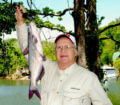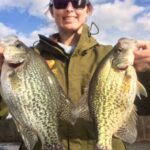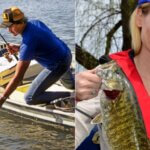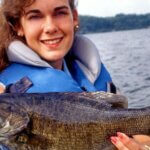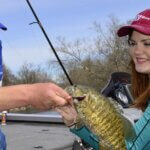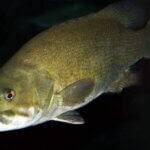Editor’s Note: I like to fish for eaters. As a child, I fished with my father on almost every day off he had. We fished on nearby rivers and lakes, caught a wide variety of fish, cleaned our catch and took them home for my mother to cook for supper. Eating what we caught extended our fishing fun and provided delicious food for our family. Let’s look at some ways to find and catch more catfish and bluegills.
 Four main species of catfish live in North America: the bullhead, the channel, the flathead and the blue. The bullhead is one of the most widely-distributed catfish, inhabiting most of the U.S. and southern Canada. The channel catfish originally was wide-ranged from southern Canada through the Great Lakes region and the central drainage systems of the U.S. south to Mexico, as well as parts of the Atlantic Coast and all the states bordering the Gulf of Mexico. Today channel catfish also have been introduced throughout other sections of the U.S.
Four main species of catfish live in North America: the bullhead, the channel, the flathead and the blue. The bullhead is one of the most widely-distributed catfish, inhabiting most of the U.S. and southern Canada. The channel catfish originally was wide-ranged from southern Canada through the Great Lakes region and the central drainage systems of the U.S. south to Mexico, as well as parts of the Atlantic Coast and all the states bordering the Gulf of Mexico. Today channel catfish also have been introduced throughout other sections of the U.S.
The flathead catfish has been introduced across the U.S. in rivers and reservoirs and has its origin in the rivers of the Mississippi Valley – the Missouri, the Ohio and Mississippi – south to Mexico. The blue catfish isn’t as abundant today as it was before the erection of power dams, but still it’s distributed in large rivers from Minnesota and Ohio southward and in the Atlantic Coastal system, with a preference for clear, swift streams flowing over bottoms of bedrock, boulders, gravel and/or sand.
Catfish anglers have realized for years that to take the most and the biggest catfish, you must pinpoint sections of a lake or a river where no one else fishes. Look for the regions of water that receive the least amount of fishing pressure. The middles of small streams and rivers that you can float down with a canoe or a johnboat often will yield the most and the biggest catfish.
* Limbline: If you’re fishing down small rivers and creeks, you can fish for catfish by setting out limblines 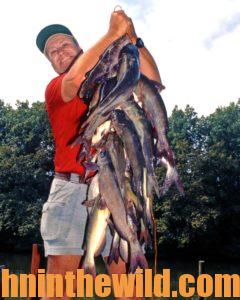 and set poles, also called bush lines, along the bank. By tying a line of braided nylon twine with a hook and a bait to a tree limb that’s overhanging the water, you can fish a large area with a small amount of tackle to improve your chances of catching catfish. Always be sure the limb you tie your line to is green and not brittle. Since a nice-sized catfish will put pressure on a limb, the branch should bend and not break under that pressure. Also set your lines at different depths to determine where the fish are. A shaking bush usually means a fish dinner.
and set poles, also called bush lines, along the bank. By tying a line of braided nylon twine with a hook and a bait to a tree limb that’s overhanging the water, you can fish a large area with a small amount of tackle to improve your chances of catching catfish. Always be sure the limb you tie your line to is green and not brittle. Since a nice-sized catfish will put pressure on a limb, the branch should bend and not break under that pressure. Also set your lines at different depths to determine where the fish are. A shaking bush usually means a fish dinner.
Landing a big catfish on a limb line is much like landing a cat on a jug. Don’t try to wrestle the catfish to the surface with the line. Often the catfish will dive and either break the line or jerk it off the limb. Instead, gently lead the catfish to the surface, and slip your net under it.
* Fish Set-Poles: Set-poles are similar to limb-lines, except a set-pole is a small limb or a river cane that has been sharpened on its big end and then stuck into the soft earth of the bank and baited. Remember with this method to position the pole at about a 45-degree angle, so that when the catfish takes the bait, the pole will bend and not pull out from the bank, while awaiting your return to check it.
* Recognize the Importance of a Portable Depth Finder: To find these secret catfish hot spots that no one else fishes, use a portable depth finder as you float down small streams and little rivers. Search for bottom breaks, small drop-offs or ledges in the bottom where the catfish hold with your depth finder. Very few, if any anglers utilize portable depth finders to find honey holes for cats when floating small  streams. Once you identify the bottom break, anchor your boat or canoe downstream of that bottom break. Cast upstream to allow your bait to move along the bottom and drop off the ledge and into the hole where the cats concentrate.
streams. Once you identify the bottom break, anchor your boat or canoe downstream of that bottom break. Cast upstream to allow your bait to move along the bottom and drop off the ledge and into the hole where the cats concentrate.
Small boat anglers enjoy using the Humminbird Helix 7 G3 Fish Finder with its clear, sharp underwater views for seeing 200 feet to each side of the boat and the PiranhaMax 4 that features a narrow and a wide beam for great detail, helping you identify catfish, the structure and contours of the bottom under the water. Visit www.humminbird.com to learn more.
* Identify Holes in the Bottoms of Rivers and Streams
You often will catch large numbers of cats in one small hole in the bottom of the river or stream. This technique works effectively when fishing large rivers too. Phil King of Corinth, Mississippi, a longtime catfish tournament winter and guide on Pickwick Lake on the Mississippi, Tennessee and Alabama border, explains, “I locate bottom breaks from 2 miles to 20 miles below the dam. I’ll motor upstream of the holes and drift with the current. I bump my bait along the bottom until I reach the lip of the break. Then, I let my bait fall into the hole. I’ll fish 20 to 30 yards down below the hole where sometimes the cats will feed above the hole, down in the hole or, below the hole. I catch some really big catfish using this 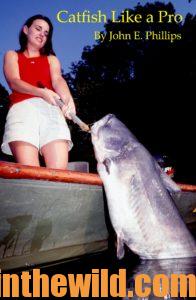 bottom-bumping, hole-fishing technique.”
bottom-bumping, hole-fishing technique.”
To learn more about catching catfish, check out John E. Phillips’ book, “Catfish Like a Pro,” available in Kindle and paperback, at http://amzn.to/W900eu. You can also get a free eBook copy of “The Catfish Catcher’s Cookbook” at https://johninthewild.com/free-books.

